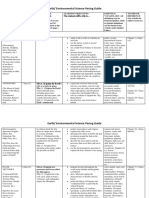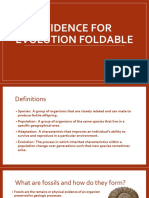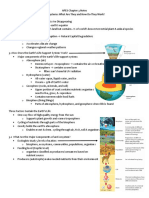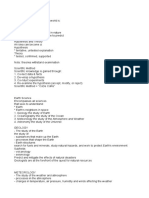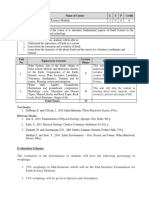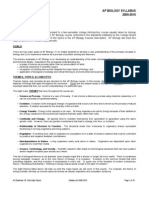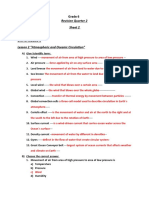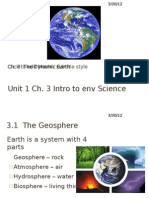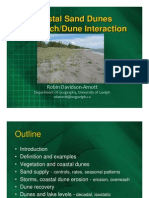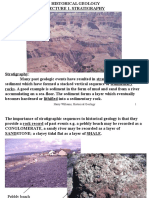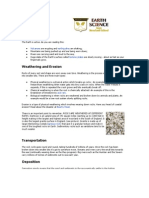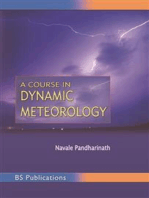0 ratings0% found this document useful (0 votes)
41 viewsEarth Science Pacing Guide
Earth Science Pacing Guide
Uploaded by
api-502019872This document outlines an Earth Science pacing guide divided into 8 units covering topics like astronomy, meteorology, climate, geology, water, energy, the biosphere, and human impacts. Unit 1 addresses the formation of the universe, Kepler's laws, and seasons. Unit 2 covers the atmosphere, heat transfer, humidity, clouds, precipitation, air pressure, winds, and air masses. Unit 3 examines global climates and the natural and human factors that influence climate, including global warming.
Copyright:
© All Rights Reserved
Available Formats
Download as PDF, TXT or read online from Scribd
Earth Science Pacing Guide
Earth Science Pacing Guide
Uploaded by
api-5020198720 ratings0% found this document useful (0 votes)
41 views1 pageThis document outlines an Earth Science pacing guide divided into 8 units covering topics like astronomy, meteorology, climate, geology, water, energy, the biosphere, and human impacts. Unit 1 addresses the formation of the universe, Kepler's laws, and seasons. Unit 2 covers the atmosphere, heat transfer, humidity, clouds, precipitation, air pressure, winds, and air masses. Unit 3 examines global climates and the natural and human factors that influence climate, including global warming.
Original Title
earth science pacing guide
Copyright
© © All Rights Reserved
Available Formats
PDF, TXT or read online from Scribd
Share this document
Did you find this document useful?
Is this content inappropriate?
This document outlines an Earth Science pacing guide divided into 8 units covering topics like astronomy, meteorology, climate, geology, water, energy, the biosphere, and human impacts. Unit 1 addresses the formation of the universe, Kepler's laws, and seasons. Unit 2 covers the atmosphere, heat transfer, humidity, clouds, precipitation, air pressure, winds, and air masses. Unit 3 examines global climates and the natural and human factors that influence climate, including global warming.
Copyright:
© All Rights Reserved
Available Formats
Download as PDF, TXT or read online from Scribd
Download as pdf or txt
0 ratings0% found this document useful (0 votes)
41 views1 pageEarth Science Pacing Guide
Earth Science Pacing Guide
Uploaded by
api-502019872This document outlines an Earth Science pacing guide divided into 8 units covering topics like astronomy, meteorology, climate, geology, water, energy, the biosphere, and human impacts. Unit 1 addresses the formation of the universe, Kepler's laws, and seasons. Unit 2 covers the atmosphere, heat transfer, humidity, clouds, precipitation, air pressure, winds, and air masses. Unit 3 examines global climates and the natural and human factors that influence climate, including global warming.
Copyright:
© All Rights Reserved
Available Formats
Download as PDF, TXT or read online from Scribd
Download as pdf or txt
You are on page 1of 1
Earth Science Pacing Guide
Unit 1: Astronomy Unit 2: Meteorology
Formation of Universe/Kepler’s Laws Layers of the Atmosphere
Rotation/Revolution Heat Transfer/Differential Heating
Seasons Humidity & Dew Point/Clouds & precip
Precession, Nutation, & Barycenter Air Pressure & Wind
Tides Air Masses
Energy from the sun Fronts
Thunderstorms & Tornadoes
Hurricane
Interpreting Weather Maps
Unit 3: Climate Unit 4: Geology
Global Climates The Rock Cycle
Factors that Influence Climate Weathering
Natural Processes that Change Climate Soil
Global Warming & Consequences Continental Drift
Faults
Plate Boundaries
Faults
Earthquakes
Volcanoes
Erosion/Deposition
Mass Movements
Unit 5: Water Unit 6: Energy
Water Cycle & Use Non-Renewable Energy
Groundwater Impacts/Mining for Resources
Watersheds/Rivers/Flooding & Drought Alternative Energy
Ocean Currents Energy Conservation
Water Pollution Types
Drinking & Wastewater Treatment
Macroinvertebrate/Biotic Index
Unit 7: Biosphere Unit 8: Human Impact
Biomes/Ecosystems Ecology Land Use
Biodiversity Urbanization
Nutrient Cycles/Food Webs/Matter/Energy Flow Human Impact on Environment
You might also like
- Ees Pacing Guide Fall 2016Document13 pagesEes Pacing Guide Fall 2016api-323312952No ratings yet
- AGS Publishing (Pearson Education Inc., Publishing As AGS Globe)Document3 pagesAGS Publishing (Pearson Education Inc., Publishing As AGS Globe)Amber JerrettNo ratings yet
- PDF Holt Environmental Science Test Bank MybookdircomDocument13 pagesPDF Holt Environmental Science Test Bank MybookdircomEunice Yau0% (1)
- Hudl & Big-StadiumsDocument2 pagesHudl & Big-StadiumsheelsNo ratings yet
- Finding Nemo Animal Ecology Final ProjectDocument4 pagesFinding Nemo Animal Ecology Final Projectapi-211601638No ratings yet
- OCS 1005 Exam 3Document46 pagesOCS 1005 Exam 3Jashayla Gillespie100% (1)
- Manchester Monarchs Education Day BookletDocument32 pagesManchester Monarchs Education Day BookletManchester MonarchsNo ratings yet
- Evidence For Evolution Foldable Use This OneDocument9 pagesEvidence For Evolution Foldable Use This Oneapi-271661638No ratings yet
- Earth Science Honors ReviewDocument26 pagesEarth Science Honors ReviewGreg SmithNo ratings yet
- 1.6 Skills Practice - Two-Dimensional FiguresDocument1 page1.6 Skills Practice - Two-Dimensional FiguresAndrew DNo ratings yet
- APES Chapter 3 NotesDocument4 pagesAPES Chapter 3 Noteskhushi100% (1)
- Famous Scientists and What They Did : Pre-K Science Series: Scientists for Kids Preschool BooksFrom EverandFamous Scientists and What They Did : Pre-K Science Series: Scientists for Kids Preschool BooksNo ratings yet
- Regents Physics--Physical Setting Power Pack Revised EditionFrom EverandRegents Physics--Physical Setting Power Pack Revised EditionRating: 5 out of 5 stars5/5 (1)
- 463 Course OutlineDocument3 pages463 Course OutlineNig Leet100% (1)
- Weather and Climate PDFDocument56 pagesWeather and Climate PDFJessicaNgSánchezNo ratings yet
- Apes Syllabus 2017-2018Document7 pagesApes Syllabus 2017-2018api-326666618No ratings yet
- Earth Science NotesDocument4 pagesEarth Science NotesjodcuNo ratings yet
- Earth Science Lecture PlanDocument1 pageEarth Science Lecture PlanAkash MahapatraNo ratings yet
- Watershed Components QuizDocument1 pageWatershed Components QuizMom AttityaNo ratings yet
- GOL 106 Exam I Study GuideDocument9 pagesGOL 106 Exam I Study GuideNick FranklynNo ratings yet
- MSC Earth Sciences Study GuideDocument55 pagesMSC Earth Sciences Study GuideAziz Asgani100% (1)
- AP Biology Syllabus 2009-2010Document10 pagesAP Biology Syllabus 2009-2010yulianaholicNo ratings yet
- Fossils Geo TimeDocument15 pagesFossils Geo TimejeffersonNo ratings yet
- Mathematic in GeologyDocument9 pagesMathematic in GeologyR.A. Muhammed HajaniNo ratings yet
- Earth Science Reference Tables 2011Document16 pagesEarth Science Reference Tables 2011api-293484562No ratings yet
- Tsunami Geology - What Causes A Tsunami?: Subduction Zones Are Potential Tsunami LocationsDocument6 pagesTsunami Geology - What Causes A Tsunami?: Subduction Zones Are Potential Tsunami LocationssupriyadiNo ratings yet
- Earth ScienceDocument32 pagesEarth ScienceJosebeth CairoNo ratings yet
- Week 4. Igneous, Sedimentary and Metamorphic RocksDocument2 pagesWeek 4. Igneous, Sedimentary and Metamorphic RocksCharlie DoanNo ratings yet
- (Vladimir N. Bashkin) Modern Biogeochemistry EnviDocument446 pages(Vladimir N. Bashkin) Modern Biogeochemistry EnviMirela KlisurićNo ratings yet
- Nitrogen Cycle GameDocument1 pageNitrogen Cycle Gameapi-324739785No ratings yet
- Revision Sheet 2 (Atmospheric and Oceanic Circulation) Model AnswerDocument4 pagesRevision Sheet 2 (Atmospheric and Oceanic Circulation) Model AnsweryoussefNo ratings yet
- Science 10 Long Range Plans 2017 RebeccaDocument4 pagesScience 10 Long Range Plans 2017 Rebeccaapi-307356982No ratings yet
- Unit 1 Ch. 3 The Dynamic EarthDocument18 pagesUnit 1 Ch. 3 The Dynamic Earthncl12142No ratings yet
- Nebular HypothesisDocument1 pageNebular HypothesisChriscel BoterosNo ratings yet
- The Bio Guide PreviewDocument41 pagesThe Bio Guide PreviewaskhachaNo ratings yet
- General Geology: Geology in Civil EngineeringsDocument27 pagesGeneral Geology: Geology in Civil Engineeringshhii aasdasdNo ratings yet
- Heliocentric Versus Geocentric Models of The Universe 1Document2 pagesHeliocentric Versus Geocentric Models of The Universe 1Prince Carlo GuillermoNo ratings yet
- Time in GeomorphologyDocument10 pagesTime in GeomorphologyvelamkonNo ratings yet
- Free Veritas Prep Complete GMAT Course Set - 12 Books Full OnlineDocument1 pageFree Veritas Prep Complete GMAT Course Set - 12 Books Full OnlineAshishrock SinghNo ratings yet
- Chapter 17-Plate TectonicsDocument37 pagesChapter 17-Plate Tectonicsncl12142No ratings yet
- 150 Branches of Geology (Earth Sciences) : July 2017Document51 pages150 Branches of Geology (Earth Sciences) : July 2017paramananda mohapatraNo ratings yet
- Geology 1st Long ExamDocument8 pagesGeology 1st Long ExamTimmy Santos-VistaNo ratings yet
- Lab 5 Newtons Second LawDocument6 pagesLab 5 Newtons Second LawAndrew GomezNo ratings yet
- Horst and Graben (Valley and Range) Refers To A Type of Topography Created WhenDocument13 pagesHorst and Graben (Valley and Range) Refers To A Type of Topography Created WhenZillah Pandiling CuratoNo ratings yet
- G11 Earth ScienceDocument14 pagesG11 Earth ScienceAlthea RivadeloNo ratings yet
- Environmental Chemistry - Grade 9Document18 pagesEnvironmental Chemistry - Grade 9nidda beeNo ratings yet
- Coastal Dunes RDADocument50 pagesCoastal Dunes RDAMagda NechitaNo ratings yet
- WeatheringDocument13 pagesWeatheringBrijeshNo ratings yet
- StratigrafiDocument22 pagesStratigrafiAdityaMangalaNo ratings yet
- Ecosystems: I. What Is An Ecosystem?Document5 pagesEcosystems: I. What Is An Ecosystem?AntonioNo ratings yet
- Elastic Potential Energy MC Questions PDFDocument4 pagesElastic Potential Energy MC Questions PDFLynn Hollenbeck Breindel0% (1)
- FoldsDocument34 pagesFoldsDheo Aldava100% (1)
- Nuclear ChemistryDocument40 pagesNuclear ChemistryBetty Weiss100% (1)
- National Academies of Sciences - 2020 - Teaching K-12 Science and Engineering During A CriDocument135 pagesNational Academies of Sciences - 2020 - Teaching K-12 Science and Engineering During A CriMichael James DrilonNo ratings yet
- Geology Lab Manual Front Matter - 12 16 10Document8 pagesGeology Lab Manual Front Matter - 12 16 10shaidaNo ratings yet
- Syllabus 7th Grade Life ScienceDocument5 pagesSyllabus 7th Grade Life Scienceapi-200963737No ratings yet
- Rock Cycle and Rock Cycle AnswersDocument4 pagesRock Cycle and Rock Cycle Answersapi-3808551100% (2)
- Climate Dynamics: Why Does Climate Vary?From EverandClimate Dynamics: Why Does Climate Vary?De-Zheng SunNo ratings yet
